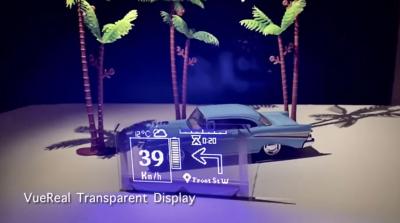MicroLED developer VueReal says that it achieved a breakthrough in its MicroSolid Printing Platform, enabling it to go below 7um LED pitch (on the wafer) for full color microLED deposition. The company reports that its newest (and smallest) microLEDs show minimal impact on EQE, and this enables high-efficiency display production.
VueReal says that its new technology could soon compete on price with OLED displays while offering higher performance, and could be viable for many display segments - from wearables through smartphones to automotive and more. According to its current tests, its microLED displays will offer a brightness of 3,000 nits (and higher), while consuming around half the power compared to the latest AMOLED displays. In addition, its printing process is highly scalable and should not have a problem handling the demands of even the smartphone industry with hundreds of millions of displays per year.
The new achievement is a combination of several technologies, including a new backplane design, a new LED structure, improvements to the printing cartridge-based transfer process, and a new display optical structure. VueReal produced a proof-of-concept prototype display, and is now working with its partners to fabricate a new display backplane and produce display samples that can be sent to companies for evaluation. VueReal's process is also highly effective in terms of the epiwafer usage. VueReal's transfer process does not require a square-stamp area (see this whitepaper for more info on wafer LED usage) and its latest LEDs have an effective pitch (on wafer) of less than 7x7um including spacing. This all means that the technology can utilize a very large percentage of its epiwafer LEDs compared to competing solutions.
While it is possible to produce even smartphone displays (which are most challenging for microLED technology), VueReal's main focus is on automotive displays, with eyes set on the smartwatch, AR and smartphone markets next.
The company's next step is to increase its internal capacity which will enable it to produce around 2 million displays per year, which should be enough for some automotive applications. The company also seeks to license its technology and offer its tools, processes and ready LED cartridges to display makers for high volume production.
Finally the company's CEO tells us that he expects the first mass-produced microLED display from VueReal to hit the market by 2025-2026.
Last month VueReal was awarded CAD$10.5 million (USD$7.7 million) in government funds to support the scale up of its micropixel fabrication and printing solutions. The total cost of its fab (which will have a capacity of 2 million displays per year) will be around $40 million CAD. The company is also set to expand the range of its custom display products for AR, smartwatches, smartphones, automotive, signage and transparent displays. Last year VueReal demonstrated high-brightness and high-transmittance transparent microLED displays which it is now offering to customers.
In February 2020 we posted an interview with VueReal's CEO. On December 2020 the company announced that its patented flipchip structure demonstrated higher yields and lower costs compared to standard vertical LED process. In 2018 VueReal closed its $10.5 million Series A funding round. In 2022, VueReal raised $14.4 million in its Series B funding round.


